Culture of Uganda
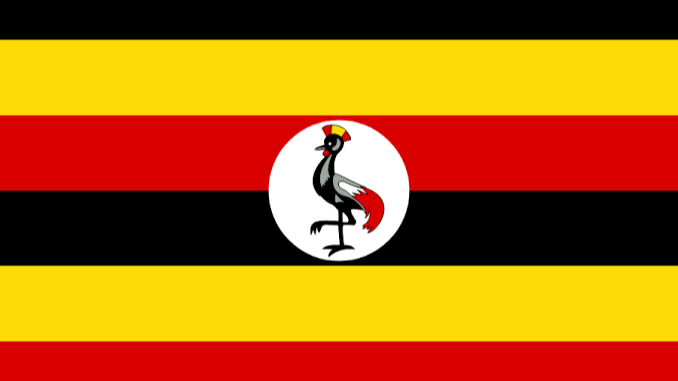
Culture Name
Ugandan
Orientation
Identification. Lake Kyoga serves as a rough boundary between Bantu speakers in the south and Nilotic and Central Sudanic language speakers in the north. Despite the division between north and south in political affairs, this linguistic boundary actually runs roughly from northwest to southeast, near the course of the Nile. However, many Ugandans live among people who speak different languages, especially in rural areas. Some sources describe regional variation in terms of physical characteristics, clothing, bodily adornment, and mannerisms, but others claim that those differences are disappearing.
Location and Geography. Bantu speakers probably entered southern Uganda by the end of the first millennium. They had developed centralized kingdoms by the fifteenth or sixteenth century, and after independence from British rule in 1962, Bantu speakers constituted roughly two-thirds of the population. They are classified as either Eastern Lacustrine or Western Lacustrine Bantu. The Eastern Lacustrine Bantu speakers include the Baganda people whose language is Luganda, the Basoga, and many smaller societies in Uganda, Tanzania, and Kenya. The Western Lacustrine Bantu speakers include the Banyoro, the Bastoro, the Banyankole, and several smaller populations in Uganda.
Nilotic language speakers probably entered the area from the north beginning about C.E. 1000. Thought to be the first cattle-herding people in the area, they also relied on crop cultivation. The largest Nilotic populations in Uganda are the Iteso and Karamojong ethnic groups, who speak Eastern Nilotic languages, and the Acholi, Langi, and Alur, who speak Western Nilotic languages. Central Sudanic languages, which arrived in Uganda from the north over a period of centuries, are spoken by the Lugbara, the Madi, and a few small groups in the northwestern part of the country.
Demography. The population was about twenty-three million in mid-1999. The Eastern Lacustrine Bantu include the Baganda, the Basoga, and the Bagisu. The Baganda, the largest ethnic group, account for about 17 percent of the population, or approximately 3.9 million people. The second largest ethnic group, the Basoga, make up about 8 percent of the population, or 1.8 million people, while the Bagisu constitute roughly 5 percent of the population, or just over a million people. The Western Lacustrine Bantu—the Banyoro, Batoro, and Banyankole people—probably constitute around 3 percent of the population, or 700,000 people each.
The Eastern Nilotic language groups include the Karamojong cluster, the Iteso and the Kakwa. The Karamojong account for around 12 percent of the population (2.8 million), the Iteso amount to about 8 percent (1.8 million), and the Kakwa constitute 1 percent (about 230,000). The Western Nilotic language groups include the Langi and Acholi as well as the Alur. Together they account for roughly 15 percent of the population, or about 3.4 million people, with the Langi contributing 6 percent (1.4 million), the Acholi 4 percent (900,000), and the Alur probably about 2 percent (460,000).
Central Sudanic languages are spoken by about 6 percent of the population, mostly in the northwest. The Lugbara (roughly 3.8 percent of the total, or 870,000) and the Madi (roughly 1.2 per cent, or 275,000) are the largest of these groups, representing the southeastern corner of a belt of Central Sudanic language speakers stretching from Chad to Sudan.
About 10,000 Ugandans of Sudanese descent are classified as Nubians. They are descendants of Sudanese military recruits who came in the late nineteenth century as part of the colonial army. Rwandans, who constituted almost 6 percent of the
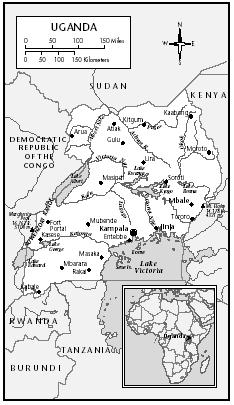
Uganda
population (more than one million) in the late 1950s, included Hutu and Tutsi groups. The government attempted to limit Rwandan influence by restricting those who lacked Ugandan citizenship to refugee camps and expelling some to Tanzania. In the late 1980s, more than 120,000 Rwandans were recognized as refugees. Asians, who in the 1969 census amounted to some seventy thousand people, mainly of Indian and Pakistani descent, were officially considered foreigners despite the fact that more than half were born in Uganda. After independence and especially when the Obote government threatened to nationalize many industries in 1969, Asians exported much of their wealth and were accused of graft and tax evasion. President Idi Amin deported about seventy thousand Asians in 1972, and only a few returned in the 1980s to claim their expropriated land, buildings, factories, and estates. In the 1990s, there were about ten thousand Asians in the country.
Linguistic Affiliation. Introduced by the British in the late nineteenth century, English was the language of colonial administration. After independence, it became the official language, used in government, commerce, and education. Official publications and most major newspapers appear in English, which often is spoken on radio and television. Most residents speak at least one African language. Swahili and Arabic also are widely spoken.
History and Ethnic Relations
Emergence of the Nation. After independence in 1962, ending a period of colonization that began in 1885, there was little indication that the country was headed for social and political upheaval. Instead, Uganda appeared to be a model of stability and progress. It had no white settler class attempting to monopolize the cash crop economy, and there was no legacy of conflict. It was the African producers who grew the cotton and coffee that brought a higher standard of living, financed education, and led to high expectations for the future.
Independence arrived without a national struggle against the British, who devised a timetable for withdrawal before local groups had organized a nationalist movement. This near absence of nationalism among the country's ethnic groups led to a series of political compromises.
National Identity. Ethnic and religious divisions as well as historical emnities and rivalries contributed to the country's disintegration in the 1970s. There was a wide gulf between Nilotic speakers in the north and Bantu speakers in the south and an economic division between pastoralists in the drier rangelands of the west and north, and agriculturists, in the better-watered highland and lakeside regions. There was also a historical division between the centralized and sometimes despotic rule of the ancient African kingdoms and the kinship-based politics elsewhere. The kingdoms were often at odds in regard to the control of land. During the colonial period, the south had railways, cash crops, a system of Christian mission education, and the seat of government, seemingly at the expense of other regions. There also were religious groups that had lost ground to rivals in the past, for example, the domination of Muslims at the end of the nineteenth century by Christians allied to British colonialism. All these divisions precluded the formation of a national culture.
Ethnic Relations. After independence, there were conflicting local nationalisms. The Buganda's large population, extensive territory in the favored south, and self-proclaimed superiority created a backlash among other Ugandan peoples. Nubians shared little sense of identification with other groups. The closely related peoples of nearby Zaire and the Sudan soon became embroiled in civil wars in the 1960s and 1970s, drawing in ethnically related Ugandans. Today relations are relatively harmonious. However, suspicion remains with the president believing to favor certain groups from the west of the country over others.
Food and Economy
Food in Daily Life. Most people, except a few who live in urban centers, produce their own food. Most people eat two meals a day: lunch and supper. Breakfast is often a cup of tea or porridge. Meals are prepared by women and girls; men and boys age twelve and above do not sit in the kitchen, which is separate from the main house. Cooking usually is done on an open wood fire. Popular dishes include matoke (a staple made from bananas), millet bread, cassava (tapioca or manioc), sweet potatoes, chicken and beef stews, and freshwater fish. Other foods include white potatoes, yams, corn, cabbage, pumpkin, tomatoes, millet, peas, sorghum, beans, groundnuts (peanuts), goat meat, and milk. Oranges, papayas, lemons, and pineapples also are grown and consumed. The national drink is waragi , a banana gin. Restaurants in large population centers, such as Kampala (the capital), serve local foods.
Basic Economy. Most food is produced domestically. Uganda exports various foodstuffs, including fish and fish products, corn, coffee, and tea. The environment provides good grazing land for cattle, sheep, and goats. Agriculture is the most important sector of the economy, employing over 80 percent of the workforce. Much production is organized by farmers' cooperatives. Smallholder farmers predominated in the 1960s and 1970s but declined as a result of civil conflict. In the 1980s, the government provided aid to farmers, and by the middle of the decade nearly a hundred ranches had been restocked with cattle.
Lakes, rivers and swamps cover about 20 percent of the land surface, and fishing is an important rural industry. The basic currency is the shilling.
Land Tenure and Property. At independence, the country was a patchwork of district administrations subdivided into counties and consolidated into
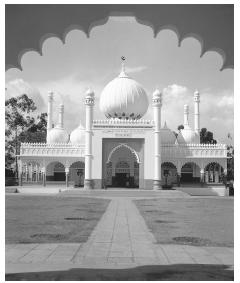
Grand Mosque of Kampala. Roughly 15 percent of Ugandans are Muslims
provinces. As a result of a treaty with the British in 1900, Uganda retained its monarchy together with a modified version of its government and a distinctive form of quasi-freehold land tenure. Land was divided between the protectorate government and the kabaka (king), chiefs, and other tribal notables. This mailo land quickly became an important element in the colonial farming economy.
Uganda has a long history of diverse laws and social systems governing land tenure. Since the promulgation of the Land Reform decree of 1975, only two systems of land tenure exist (leasehold and customary tenure), but in practice a complex mixture of systems (including customary, leasehold, and freehold) continue to exist. The government attempted to simplify and unify the land tenure system. A major development in that process has been the inclusion of land tenure in the constitution of 1995. However, issues such as women's right to own land require further consideration.
Commercial Activities. The major goods and services produced for sale are foodstuffs and cash crops for exportation, with coffee as the major export crop. Uganda escaped widespread famine in the late 1970s and 1980s because many people, including urban residents, resorted to subsistence cultivation. Both commercial and subsistence farming operated in the monetary and nonmonetary sectors, presenting the government with problems of organization and taxation. By the late 1980s, government reports estimated that about 44 percent of gross domestic product (GDP) originated outside the monetary economy. Most nonmonetary activity was agricultural.
Major Industries. When the present government seized power in 1986, industrial production was negligible, consisting mostly of the processing of crops and the production of textiles, wood and paper products, cement, and chemicals. Industry was a small part of GDP in the late 1980s, operating at approximately one-third of the level of the early 1970s. Under Museveni, there has been some industrial rejuvenation, although this has amounted to not much more than the repair of damage done during the civil war to the industrial infrastructure. The sugar industry was rehabilitated through joint ventures involving the private sector and the government. By the 1990s there was a refining capacity of at least 140,000 tons of sugar annually. Other rehabilitated industries include beer brewing, tobacco, cotton, and cement. About 4 percent of adults worked in industry by the 1990s. During the 1990s, industrial growth was 13.2 percent.
Trade. In 1998, the country exported products worth $575 million. The main export commodities were coffee (54 percent of the total value), gold, fish and fish products, cotton, tea, and corn. The countries receiving most of these products were Spain, Germany, the Netherlands, France, and Italy. The main imports include chemicals, basic manufactured goods, machinery, and transport equipment.
Division of Labor. In the mid-1990s the labor force was estimated to be about 8.5 million, with more than 85 percent working in agriculture, 4 percent in industry, and 10 percent in the services sector. Jobs are allocated according to ability and preference.
Social Stratification
Classes and Castes. Although there are no castes, there is a relatively high degree of social inequality. In the mid-1990s, 55 percent of the population lived below the poverty line. The top 10 percent owned about one-third of the available wealth, while the bottom 10 percent owned 3 percent. Wealth distribution is governed by class position. The richest people live mostly in the capital, Kampala.
Symbols of Social Stratification. Social stratification is governed primarily by level of education and status derived primarily from employment. Among the elites, English is the language of communication, and these people dress in a modern Western fashion. Others tend to wear traditional dress.
Political Life
Government. Under the constitution of 1995, legislative power is in the hands of a unicameral parliament (the National Resistance Council) with 276 members (214 elected directly and 62 appointed). Executive powers are held by the president, who is directly elected for a five-year term. On coming to power in 1986, the government introduced "no-party" democracy known as the "movement system" with a national network extending from the capital to the rural areas. Only one political organization, formerly the National Resistance Movement (or NRM) and now known as the "Movement," is recognized; it is the party of President Museveni. Among the parties that exist but are not allowed to sponsor candidates, the most important are the Ugandan People's Congress (UPC), the Democratic Party (DP), and the Conservative Party (CP).
Leadership and Political Officials. It is alleged that one of the main criteria for advancement in the current government is whether an individual fought in President Museveni's guerrilla army, which was instrumental in bringing the regime to power in 1986. Those people are said to have achieved their positions through a combination of hard work, influence peddling, and corruption.
Social Problems and Control. After the victory of the National Resistance Army (NRA) in 1986, the NRA assumed responsibility for internal security. The police force was reorganized and, together with other internal security organs, began to enforce law and order in all districts except those experiencing rebel activity. There are two continuing civil wars against the "Lord's Resistance Army" and against guerrillas based in the Sudan. In 1995, the government established a legal system based on English common law and customary law. There is a court of appeal and a high court, both with judges appointed by the president. The most common crimes are theft and, in some parts of the country, banditry.
Military Activity. Uganda has an army, a navy, and an air force. The NRA has about seventy thousand troops. Recruitment is voluntary; there is no fixed term of service, and both men and women serve. In 1999, Ugandan military forces supported the rebel forces in the civil war in the Democratic Republic of Congo.
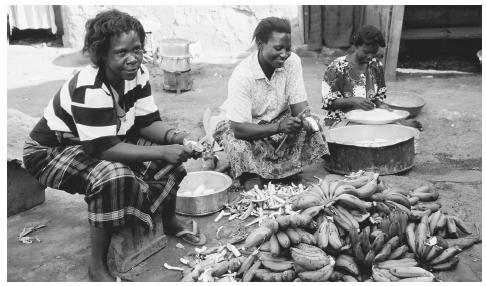
Women preparing food in Kampala. All meals are prepared by women in Uganda; boys over age twelve are banned from the kitchen.
Social Welfare and Change Programs
In 1987, the government launched a four-year Rehabilitation and Development Plan to restore the nation's productive capacity, especially in industry and agriculture, and rehabilitate the social and economic infrastructure. The plan targeted industrial and agricultural production, transportation, and electricity and water services, envisioning an annual 5 percent growth rate. Transportation would receive the major share of funding, followed by agriculture, industry and tourism, social infrastructure, and mining and energy. Although the international financial community provided debt rescheduling and new loans, the level of economic recovery was modest. Improved security and private sector development contributed to economic growth and the rehabilitation of the social infrastructure in the 1990s, but external shocks, an overvalued currency, and high government spending limited economic progress.
Nongovernmental Organizations and Other Associations
Political conflict and the near disintegration of the state under Milton Obote and Idi Amin in the 1970s and early 1980s, led to the incorporation of autonomous self-help organizations and nongovernmental organizations (NGOs). Foreign and indigenous NGOs concerned with developmental, social, and political goals have flooded Uganda since the mid-1980s. In general, NGOs have been effective in addressing the needs of service provision and alleviating poverty. For groups of traditionally disadvantaged people such as physically disabled persons and women, NGOs have provided guaranteed political representation at every level of the society.
Gender Roles and Statuses
Division of Labor by Gender. Traditionally, women's roles were subordinate to those of men despite the substantial economic and social responsibilities of women in traditional Ugandan societies. Women were taught to accede to the wishes of their fathers, brothers, husbands, and other men and to demonstrate their subordination to men in public life. Into the 1990s, women in rural areas of Buganda were expected to kneel when speaking to a man. However, women had the primary responsibility for child care and subsistence agriculture while contributing to cash crop agriculture. Many Ugandans recognized women as important religious leaders who sometimes had led revolts that
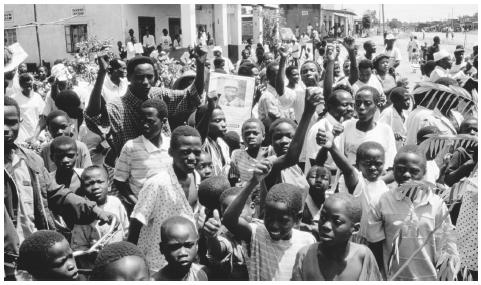
The people of Kalunga village celebrate the victory of Kintu Musoke in the 1994 nonpartisan general election in Uganda.
overthrew the political order dominated by men. In some areas, women could own land, influence crucial political decisions made by men, and cultivate cash crops.
The Relative Status of Women and Men. In the 1970s and 1980s, political violence had a heavy toll on women. Economic hardship was felt in the home, where women and children lacked the economic opportunities available to most men. Women's work became more time-consuming, and the erosion of public services and infrastructure reduced access to schools, hospitals, and markets. However, some Ugandan women believed that the war years strengthened their position in society, and the Museveni government has pledged to eliminate discrimination against women. During the civil war, women were active in the NRA. The government decreed that one women would represent each district on the National Resistance Council, and the government owned Uganda Commercial Bank established a rural credit plan to make farm loans available to women.
Marriage, Family, and Kinship
Marriage. Family prosperity in rural areas involves the acquisition of wives, which is accomplished through the exchange of bridewealth. Since the 1950s a ceiling on bridewealth has been set at five cows and a similar number of goats. The payment of bridewealth is connected to the fact that men "rule" women. Polygynous marriages have reinforced some aspects of male dominance but also have given women an arena for cooperating to oppose male dominance. A man may grant his senior wife "male" status, allowing her to behave as an equal toward men and as a superior toward his other wives. However, polygynous marriages have left some wives without legal rights to inheritance after divorce or widowhood.
Domestic Unit. The extended family is augmented by a kin group. Men have authority in the family; household tasks are divided among women and older girls. Women are economically dependent on the male next of kin (husband, father, or brother). Dependence on men deprives women of influence in family and community matters, and ties them to male relationships for sustenance and the survival of their children.
Inheritance. Land reform is a continuing aspect of constitutional debate. Suggestions for a new land policy were part of the draft constitution submitted to the president of the Constitutional Commission in late 1992, though little consideration had been given to the issue of women's right to own and
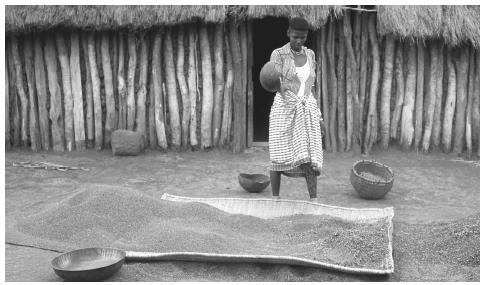
A woman winnowing grain in the Virunga National Park. More than 80 percent of the workforce is employed in agriculture.
inherit land. Although women make a significant contribution in agriculture, their tenure rights are fragile. The determination and protection of property rights have become important issues as a result of civil war and the impact of AIDS. However, the state's legal stand on inheritance recognizes the devolution of property through statutory as well as customary law.
According to the law, a wife equally with a husband is entitled to 15 percent of the spouse's estate after death. The practice, though, is that in the majority of cases a man inherits all of his wife's property, while culture dictates that a woman does not inherit from her husband at all. In other words, regarding inheritance, where there is conflict between cultural unwritten law and the written modern law, the cultural laws tend to take precedence.
Kin Groups. For many people, clan, lineage, and marriage provide the framework of daily life and access to the most significant resources. Farming is largely a family enterprise, and land and labor are available primarily through kin.
Socialization
Infant Care. Virtually all infant care is undertaken by women and older girls at home.
Child Rearing and Education. Mothers bore an average of over seven children in the late 1990s, and the use of family planning is low. The death of children is commonplace, with an estimated ninety deaths per one thousand live births. Boys are more likely to be educated to the primary and secondary levels than are girls. Among the 62 percent of the population that is literate, nearly three-quarters are men.
Higher Education. Established in 1922, Makerere University in Kampala was the first college in East Africa. Its primary aim was to train people for government employment. In the 1980s, it expanded to include colleges of liberal arts and medicine serving more than five thousand students. In the early 1990s, there were about nine thousand students. The Islamic University at Mbale, financed by the Organization of the Islamic Conference, opened in 1988. This college provides Islamic educational services primarily to English-speaking students from African countries. In 1989, a second national university campus opened in Mbarara, with a curriculum designed to serve rural development needs. Development plans for higher education rely largely on international and private donors. Most residents value higher education, perceiving it as an essential aspect of national development.
Etiquette
Shaking hands is the normal form of greeting. Casual dress is considered appropriate in the daytime and evening. It is customary to give waiters and taxi drivers a 10 percent tip. Etiquette is important at family meals. When a meal is ready, all the members of the household wash their hands and sit on floor mats. Visitors and neighbors who drop in are expected to join the family at a meal. Normally a short prayer is said before the family starts eating. During the meal, children talk only when asked a question. It is considered impolite to leave the room while others are eating. Leaning on the left hand or stretching one's legs at a meal is a sign of disrespect. When the meal is finished, everyone in turn gives a compliment to the mother.
Religion
Religious Beliefs. One-third of the population is Roman Catholic, one-third is Protestant, and 16 percent is Muslim; 18 percent believe in local religions, including various millenarian religions. World religions and local religions have coexisted for more than a century, and many people have established a set of beliefs about the nature of the universe by combining elements of both types. There is a proliferation of religious discourses centering on spirits, spirit possession, and witchcraft.
Religious Practitioners. Religious identity has economic and political implications: church membership has influenced opportunities for education, employment, and social advancement. Religious practitioners thus are expected to provide a range of benefits for their followers. Leaders of indigenous religions reinforce group solidarity by providing elements necessary for societal survival: remembrance of ancestors, means of settling disputes, and recognition of individual achievement. Another social function of religious practitioners is helping people cope with pain, suffering, and defeat by providing an explanation of their causes. Religious beliefs and practices serve political aims by bolstering the authority of temporal rulers and allowing new leaders to mobilize political power and implement political change.
Rituals and Holy Places. In Bantu-speaking societies, many local religions include a belief in a creator God. Most local religions involve beliefs in ancestral and other spirits, and people offer prayers and sacrifices to symbolize respect for the dead and maintain proper relationships among the living. Mbandwa mediators act on behalf of other believers, using trance or hypnosis and offering sacrifice and prayer to beseech the spirit world on behalf of the living.
Uganda has followers of Christianity, Islam, and African traditional religions. Ugandan Muslims make pilgrimages to Mecca when they can. Followers of African religions tend to establish shrines to various local gods and spirits in a variety of locations.
Death and the Afterlife. Death is sometimes interpreted in the idiom of witchcraft. A disease or other cause of death may not be considered the true cause. At a burial, if the relatives suspect someone of having caused the deceased person's death, a spirit medium may call up the spirit of the deceased and ask who really killed him or her.
Medicine and Health Care
Health services deteriorated in the 1970s and 1980s, as a result of government neglect, violence, and civil war. In the 1990s, measles, respiratory tract infections, and gastro enteritis caused one-half of all deaths attributed to illness, and malaria, AIDS, anemia, tetanus, whooping cough, and respiratory tract infections also claimed many lives. Infant mortality was often caused by low birth weight, premature birth, or neonatal tetanus. The entire health care system was served by less than a thousand doctors in the 1990s. Care facilities included community health centers, maternity clinics, dispensaries, leprosy centers, and aid posts. Today there is at least one hospital in each district except the southern district of Rakai. In the sparsely populated northern districts, people sometimes travel long distances to receive medical care, and facilities are inferior to those in the south. Those who live far from or cannot afford modern health care depend on traditional care. Women are prominent among traditional healers.
Secular Celebrations
The major holidays are New Year's Day, 1 January; Liberation Day, 26 January; International Women's Day, 8 March; Labor Day, 1 May; National Heroes Day, 9 June; and Independence Day, 9 October.
The Arts and Humanities
Support for the Arts. Most artists are self-supporting as there is virtually no state support. Small-scale, local initiatives take place, but it has been
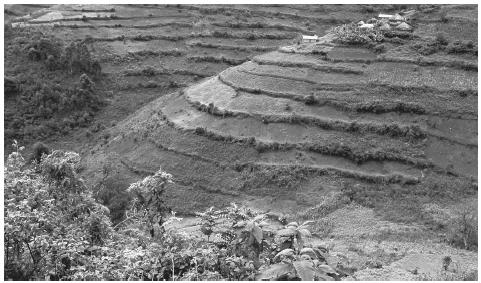
A farm with terraced fields near Kibale. Coffee, cotton, tea, and corn are among the most common agriculture exports.
difficult to establish viable sectors because of the disruptions caused by long-term political conflict and economic decline.
Literature. The development of literature is at an early stage. It has been held back by the years of civil war.
Graphic and Performance Arts. Performing arts often are associated with different ethnic groups throughout the country.
The State of the Physical and Social Sciences
The physical and social sciences are generally under-developed as a result of civil instability and conflict and the development of other priorities centered on national reconstruction. Makerere University is still in operation but virtually all expatriate staff, once the backbone of the teaching staff, have been long gone. Little research is currently undertaken because of a lack of up-to-date books, journals, or computers.
Bibliography
Abid, Syed, ed. Uganda Women in Development, 1990.
Allen, Tim. "Understanding Alice: Uganda's Holy Spirit Movement in Context." Africa 61 (3): 37–39, 1991.
Antrobus, P. "The Empowerment of Women." Women and International Development 1 (2): 189–207, 1989.
Bernt Hansen, Holger, and Michael Twaddle eds. Uganda Now: Between Decay and Development, 1988.
——. Developing Uganda, 1998.
Bwegye, F. A. W. The Agony of Uganda, 1985.
Dicklich, Susan. "Indigenous NGOs and Political Participation." In Holger Bernt Hansen and Michael Twaddle, eds. Developing Uganda 145–158, 1998.
Furley, Oliver. "Uganda's Retreat from Turmoil?," Conflict Studies 196, 1986.
Gertzel, Cherry. "Uganda's Continuing Search for Peace." Current History 89 (547): 205–228, 231–232, 1990.
Harlow, Vincent, and E. M. Chilver, eds. History of East Africa, 1965.
Ingham, Kenneth. The Making of Modern Uganda, 1983.
Jorgensen, Jan Jelmert. Uganda: A Modern History, 1981.
Kabwegyere, T. B. The Politics of State Formation and Destruction in Uganda, 3rd ed. 1995.
Kasfir, Nelson. The Shrinking Political Arena: Participation and Ethnicity in African Politics, 1976.
——. "Land and Peasants in Western Uganda: Bushenyi and Mbarara Districts." In Holger Bernt Hansen and Michael Twaddle, eds. Uganda Now: Between Decay and Development, 1988.
Khadiagala, G. M. "State Collapse and Reconstruction in Uganda." In William I. Zartman, ed. Collapsed States, 1995.
Livingstone, Ian. "Developing Industry in Uganda in the 1990s." In Holger Bernt Hansen and Michael Twaddle, eds. Developing Uganda, 1998.
Marquardt, Mark A., and Abby Sabina-Zziwa. "Land Reform in the Making." In Holger Bernt Hansen and Michael Twaddle, eds. Developing Uganda, 1998.
Mbowa, Rose. "Theatre for Development: Empowering Ugandans to Transform Their Condition." In Holger Bernt Hansen and Michael Twaddle, eds. Developing Uganda, 1998.
Nsibambi, Apolo R. "The Restoration of Traditional Rulers." In Holger Bernt Hansen and Michael Twaddle, eds. From Chaos to Order: The Politics of Constitution-Making in Uganda, 1996.
Omara-Otunu, Amii. Politics and the Military in Uganda, 1987.
——. "The Dynamics of Conflict in Uganda." In Oliver Furley, ed. Conflict in Africa, 1995.
Roberts, A. "The Sub-Imperialism of the Baganda." Journal of African History 8 (3): 435–450, 1962.
Sathymurthy, T. V. The Political Development of Uganda, 1900–1986, 1986.
Southall, Aidan W. "Social Disorganization in Uganda: Before, During, and After Amin." Journal of Modern Africa Studies 18 (4): 627–656, 1980.
Tindigarukayo, Jimmy, K. "Uganda, 1979–85: Leadership in Transition." Journal of Modern African Studies 26 (4): 607–22, 1988.
Twaddle, Michael, ed. Expulsion of a Minority, 1975.
Van Zwanenburg, R. M. A, and Anne King. An Economic History of Kenya and Uganda, 1800–1970, 1975.
Watson, Catherine. "Uganda's Women: A Ray of Hope." Africa Report 33 (6): 32–35, 1988.
Welbourn, F. B. Religion and Politics in Uganda, 1952–1962, 1965.
Werbner, Richard. Ritual Passage, Sacred Journey, 1989.
World Bank. Uganda: Towards Stabilization and Economic Recovery, 1988.
——. Uganda: The Economic Impact of AIDS, 1991.
——. Uganda: Agriculture Sector Memorandum, 1991.
